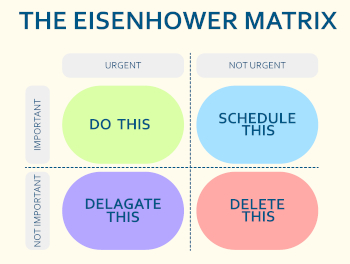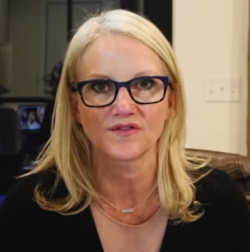Turn Your Dreams into Reality


‘Vision without action is merely a dream. Action without vision just passes time.’ – Joel A. Barker
As February draws to a close, you may feel your commitment to your new year’s resolutions (also known as ‘Dreams for 2024’) slipping away.
There’s no need for a wavering mindset. Here are a few simple ‘take action’ tactics you can use to ensure you turn your 2024 dreams into reality.
The Eisenhower Matrix
‘I have two kinds of problems, the urgent and the important. The urgent are not important, and the important never urgent.’ – Dwight D. Eisenhower

Are you having a problem prioritizing what needs to get done in your business? The Eisenhower Matrix (named after Dwight D. Eisenhower, 34th President of the U.S.) is a simple daily exercise to ensure you prioritize your to-do list properly. We often drain our mental battery with items that could be easily delegated or removed. The Matrix eliminates that wasted energy.
When you start your day with the Eisenhower Matrix, you sort your ‘to-dos’ into quadrants based on what you’ll tackle first, what you’ll schedule for later, what you’ll delegate to team members, and what you’ll delete.
To start, divide a sheet of paper into four quadrants and label them appropriately (see sample below).

- Quadrant one: ‘Urgent and Important’ are the tasks that need to get done ASAP.
- Quadrant two: ‘Important and Not Urgent’ should be time-blocked for later or scheduled.
- Quadrant three: ‘Urgent and Not Important’ should be delegated, as they don’t need your skillset. These are often the tasks we feel we can do ‘faster’ than another team member but that we need to learn to delegate.
- Quadrant four: ‘Not Urgent and Not Important’ should be deleted.
It can be difficult at first to determine what activities should go where, and that’s because as business owners you may feel everything is important. Try it out for a few weeks to get a feel for what you can start to delegate and completely delete. Here’s an example of things you might need to prioritize.
| Urgent | Not Urgent | |
| Important | DO Cope with an emergency Authorize payroll Meet with your key people to plan work for the day/week | SCHEDULE Schedule meeting to review Health and Safety Protocols Review and approve monthly marketing email newsletter |
| Not Important | DELEGATE Order new pressing pads Create job posting for office administrator Design report of B2B sales | DELETE File/sort emails Redesign employee notices board Tinkering with old equipment |
Mel Robbins’ The 5-Second Rule
‘You are just five seconds away from a totally different life.’ – Mel Robbins

Mel Robbins’ YouTube video ‘How to Stop Screwing Yourself Over’ has been viewed over 30 million times. Though the TED Talk is 20 minutes, it was Mel’s ‘Five-Second Rule’ that made her speech go viral. She argues that you need to trick your mind into action through simply counting down from five.
Here’s how it works: the moment you feel yourself hesitate or resist something you know you should do, count down out loud 5-4-3-2-1 to interrupt your brain, and then jump into action on 1. Mel argues that this trick interrupts the brain’s prefrontal cortex so that your ‘mental habits take over and kill your instinct to change.’ It’s a simple tool that can make a huge impact.
Remember Your Why
‘Working hard for something we don’t care about is called stress. Working hard for something we love I called passion.’ – Simon Sinek
Ironically, sometimes putting your head down and taking action can also make you lose sight of your end goal. Before embarking on your next dream, it can be helpful to understand your ‘Why.’

Simon Sinek, business author and leader, popularized ‘Starting With Why.’ It’s a tool and framework that leaders can use to inspire action by creating a business vision that is emotional rather than transactional. Simon challenges you to think ‘outside-in.’ ‘It’s not about what you do, but why you do it.’ He looks at Apple as an example, arguing that Apple’s ‘why,’ is ‘to think differently and challenge the status quo’ and their ‘what’ is simply to create technology products.

At Gibson’s, our ‘why’ is making life easier for our clients, team members, and our community; our ‘what’ is providing dry cleaning and laundry services. Your company’s ‘why’ may be saving your clients time, making them feel confident, or adding harmony and organization to the home. Finding your team’s ‘why’ can be a guiding star and something your team can stand behind to find their purpose in the minutia.
[Not Really] Warren Buffet’s ‘5/25’ List
‘No. You’ve got it wrong, Mike. Everything you didn’t circle just became your Avoid-At-All-Cost list. No matter what, these things get no attention from you until you’ve succeeded with your top 5.’
While researching this article, I was surprised to learn that the Warren Buffett ‘5/25’ rule is a ‘fake.’ However, I still think it provides immense value. The story alleges that Warren Buffet, one of the world’s richest people, helped his personal pilot Mike Flint to organize his career priorities in a three-step exercise.
Here’s how it works.

- Start with a list of 25 career and/or personal goals. It’s important to make an exhaustive list.
- Review this list and narrow it down to only five goals. Circle these five goals and write them on a separate list.
- Going forward you should only focus on the ‘list of five,’ and completely disregard the other 20.
As business owners, it’s important to eliminate the unnecessary goals and only focus on the few important things that will move the needle. Making small amounts of progress across 20 goals is going to create a much smaller impact than accomplishing one major goal. You can also do this exercise for a shorter timeline like a week or a month.
Habit-Stacking
‘It’s better to do less than you hoped than to do nothing at all. One of the best ways to build a new habit is to identify a current habit you already do each day and then stack your new behaviour on top. This is called habit stacking.’ – James Clear

Creating intentional and well-formed habits is critical when it comes to achieving your goals. While not a new practice, ‘Habit Stacking’ is a habit hack that’s been re-popularized by author James Clear (Atomic Habits).

Habit stacking involves pairing one positive behaviour or habit with another. Let’s say you have a goal to drink more water. Rather than set an alarm on your phone, pair it with a concrete habit you already do every day. For example, drink a glass of water after brushing your teeth. Then build on that pair by adding making your bed, texting a loved one, and so on.
Mel Robbins is also a fan of habit stacking and has developed The Million-Dollar Morning Routine using the habit stacking principal when she wakes up.
Do you have any favourite tactics or tricks to refocus your mindset and jump into action? Share with us in the comments below.






